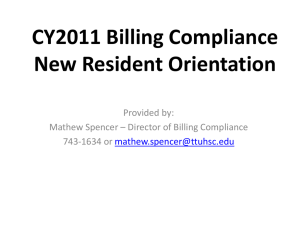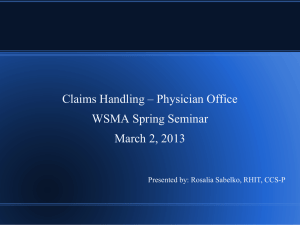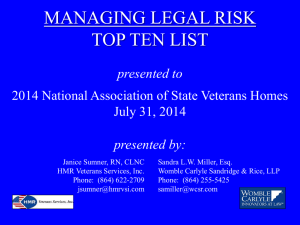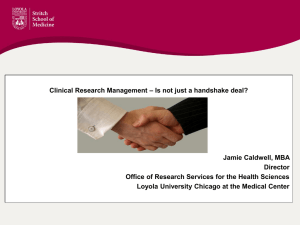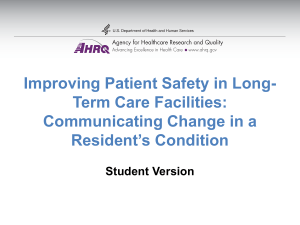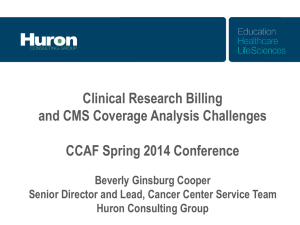Consultations - Billing Compliance
advertisement
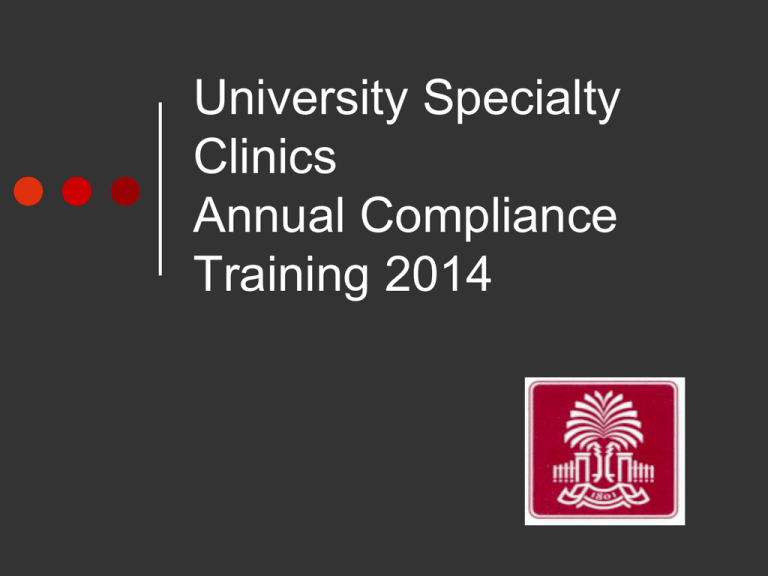
University Specialty Clinics Annual Compliance Training 2014 Billing Compliance In Practice Billing Compliance Plan Reviewed in orientation also on the website Formalizes expectation that employees will report concerns Addresses protection against retaliation Code of Conduct Signed at orientation An agreement to comply with the Billing Compliance Plan Why have a compliance plan? State Investigative Agencies Who’s looking? Dept. of Health & Human Services Medicaid Fraud Control Unit Federal Investigative Agencies Federal Bureau of Investigation Office of Inspector General Internal Revenue Service Palmetto Government Benefits Administrators Please Contact Us With Compliance Concerns New information from specialty society that will change how something is billed Uneasiness with the way services are being billed Advice regarding particular situations prior to billing Hearing information that is contrary to your current understanding Things to Remember About New Faculty Services provided by a new faculty member cannot be billed until credentialing is completed The co-signature of a current faculty member on a service provided by a new faculty member does NOT create a billable service History of the False Claims Act Originally enacted 1863 under President Lincoln Targeted unscrupulous defense contractors billing for defective goods Recognized that citizens might have information that government did not Allows citizens to sue on behalf of the government and share in the rewards (Qui tam) Protects these whistleblowers from retaliation Amended 1986. Expanded use in healthcare fraud How does the False Claims Act work in healthcare? Must have specific knowledge that the defendant has knowingly submitted (or caused to be submitted) false claims to the United States Must file an official complaint and turn over all evidence Must be first to file Department of Justice will decide whether to become involved based on scope, strength of evidence, $$ New on the Horizon for 2014 New Government Guidelines for Clinical Trials Effective January 1, 2014, Medicare policy updates and Affordable Care Act brought major changes to billing compliance for clinical trials Under these laws, health plans cannot: Deny a person the right to take part in a clinical trial Limit or deny routine patient costs for items or services connected with the clinical trial Discriminate against a person on the basis of their participation in a study Clinical Trials According to the new laws, insurance companies do not need to pay for: Treatments, devices, or services that are usually covered by the sponsor Items and services only needed for data collection and analysis Any services that are clearly not in line with the established standards of care for a certain diagnosis To ensure compliance with regulations, communication regarding regulatory statues and study participants needs to flow through: Principle investigator and faculty participants Research administration and study staff Nursing staff and nurse auditors Billing and coding personnel Patient registration personnel What is the impact? Transmittal 540 (effective 9/8/14) Authorizes the MAC’s (Palmetto GBA) and ZPIC (fraud investigators) the discretion to deny claims that are “related” before or after the claim in question has been processed. When Part A claim is in question, Part B claim may be denied or recouped. CMS example: • The MAC performs post-payment review of the admitting physician’s Part B services. For services related to inpatient admissions that are denied because they are not appropriate for Part A payment (i.e., services could have been provide as outpatient or observation), the MAC will review the hospital record. For services where the patient’s history and physical, physician progress notes or other hospital documentation does not support the medical necessity for performing the procedure/service, post-payment recoupment will occur for the performing physician’s Part B service. New Proposals by CMS Established a policy to allow payment for complex chronic care management to primary care practitioners Is proposing to transform all 10- and 90-day global codes to 0-day global codes in CY 2017 To expand telehealth services to include annual wellness visits, psychoanalysis, psychotherapy, and prolonged E/M services Consultations What Is Expected for Consultation Documentation? Request: Inpatient - Request and response in common record Office - Records must clearly indicate the request for consultation vs new patient service Strongly recommend getting hardcopy request Render: Levels of service- same requirements as new patient office visits regardless of location Respond: Must have a process to ensure that a written response is sent What Documentation is required for a Level Five Consultation? Comprehensive History Four descriptors of the History of Present Illness Remember to include an element of Past, Family and Social history or a reason why it cannot be obtained A ten system review of systems Examination of Eight Organ Systems / Comprehensive specialty specific / 18 bullets from 9 organ systems Medical Decision Making that includes two of the three : Diagnosis, Data, Risk at the highest level I spent 45 minutes explaining ……to the patient…. What Happens When I Spend Most of the Visit in Counseling? Medically Appropriate Counseling is a discussion of : Prognosis Test results Educating patient and family about treatment or disease Risks and benefits of management and/or follow up When more than 50% of a face to face visit is spent in medically appropriate counseling, the level of service can be chosen based on the total face to face time In the hospital setting, total time includes bedside time and time on the patient’s unit or floor What Codes Do I Use? The same CPT codes are used. A 99214 could be chosen if the visit was documented as: An extended exam of two to seven organ systems for a new problem assessed as a moderate risk to the patient OR A 25 minute face to face visit by the attending with 15 minutes spent in medically appropriate counseling with a description of the content of the discussion What Has to be Documented? If medically appropriate counseling dominated the visit, document : 1. Total time face to face with the patient 2. Counseling Time > 50% 3. Content of the discussion Remember : Only the billing provider’s face to face time can be considered. Staff and Resident time cannot. (In the hospital setting, total time includes bedside time and time on the patient’s unit or floor) Total Times for Billing Based on Counseling Time 99205 (Office visit) 99245 (Office consult) 99255 (Inpatient consult) 60 minutes 80 minutes 110 minutes Established patient visits 99215 99214 40 minutes 25 minutes Reminders Things to Remember About an Electronic Medical Record A secure log in, password and electronic signature identifies the provider Everyone, including students, must log in with their own password before documenting Templates can be helpful prompts but be mindful of the quality of the clinical record Copy/paste and cloned note increase the risk of error and leads to questions of authenticity in the medical record Things to Remember About Reporting Diagnosis Codes Goal: Payment on the first submission Diagnosis codes explain why this particular service was provided that day Listing diagnosis codes that were not specifically addressed on a visit misrepresents the service Documentation must support choice Insurers have CPT/diagnosis combinations that will not be paid What Do I Document for Tests? We cannot defend the medical necessity for a test that is never shown to be used in treating the patient The reason for all tests/procedures/x-rays must be documented in the clinical record You must then address all findings/results in the clinical record A process must be in place for insuring that test results are acknowledged Teaching Documentation Medicare Teaching Modifiers Medicare services provided with a resident must be filed with a GC or GE modifier GC modifier tells Medicare That a resident was involved in the service That the attending examined the patient as well That there may be two notes to document the service GE modifier tells Medicare that we are using the Primary Care Exception Outpatient Teaching Requirements Teaching Physician Requirements Medicare The Teaching Physician be present in the office suite and personally evaluate the patient during the visit The Teaching Physician must: • Be physically present with the resident for the key portions of the E/M service OR • Repeat the key portions of the service independently Documentation Requirements Medicare The Teaching Physician must: • Link their note to the resident’s signed note • Document that they have examined the patient • Document their teaching interaction with the resident • Document their agreement and/or changes to the residents assessment and plan of care Both the resident and the Teaching Physician must sign their note in the medical record GC Modifier is required to indicate the residents involvement Office and Outpatient Medicare Using the Primary Care Exception You do not have to see the patient You must be present in the office suite You must personally document your presence and participation You must link your note to the resident’s note in order to use the resident’s documentation to support the level of service These Medicare claims will need a GE modifier Outpatient Teaching Requirements Teaching Physician Requirements All Payers Except Medicare The Teaching Physician must be present in the office suite and immediately available to direct or provide patient services Documentation Requirements All Payers Except Medicare The medical record must include a statement referencing the Teaching Physician’s presence and involvement in the service Both the resident and the Teaching Physician must sign the note in the medical record No Modifier is required for resident involvement Inpatient Teaching Documentation Inpatient Teaching Documentation One Standard- All Payers Note the Date of service in the documentation Reference specific resident’s note if used to choose the level of service May link to Resident’s Admission H&P if patient is seen within 24 hours May link to resident notes from the same calendar date for follow-up visits and consultations Medicare claims will need a GC modifier Examples of subsequent hospital visits 99231 99231 99233 99232 99233 99232 1. One or two established problems that are stable. Chest x-ray ordered. 2. One established problem that is worsening. Pulmonary function test ordered. 3. Two established problems worsening and the decision not to resuscitate. 4. Three established problems that are stable or one new problem. IV antibiotics 5. A new problem requiring additional work-up and posing a threat to life or a bodily function 6. Two established problems, one stable and one worsening. Change in antibiotic. These examples assume that the history an exam meets the appropriate level of service Teaching Documentation for Procedures Were you present and is that documented? Documenting Procedures When Residents Are Involved Procedures are separately billable only if documented in a separately identifiable note This includes minor office procedures Attending presence during the procedure must be documented in that separately identifiable note See procedure presence guidelines on the Compliance website What Does that Documentation Look Like? Attending presence and participation can be documented by the resident or the attending Just listing the attending’s name does not meet the billing requirement for any payer Attending: Dr. X Not Billable Attending: Dr. X was present for the central line placement. Billable If your presence has been clearly documented by the resident, only a co-signature is required Things to Remember about Teaching Notes in Electronic Medical Records Medicare A canned statement (“macro”) can be used as a base - if additional clinical detail is present Refer to Medicare Teaching brochure on the Compliance website Signatures are automatically timed and dated If the attending note is completed before the resident’s note is signed - cannot link to incomplete note All Other Payers Be sure that the statement of presence clearly notes “present at the time of the visit” Things to Remember about Students and Billing The resident teaching supervision and documentation rules do not apply to any other kind of student. Students are not licensed providers of service. They are not recognized by insurance plans Procedures done by students are not billable What a Medical Student Can Do A student can act as a scribe: Records information at the direction of the attending Must Note “Acting as scribe for Dr. ____” Both signatures are required A student can independently record a PFSH and ROS. The attending references the student’s note, documents review and confirmation of that information, writes own HPI, exam and plan. Billing Compliance 15 Medical Park, Suite 300 256-0977 (Fax) If you have question, please contact the Compliance Department. Tara Farmer, MA, LPC/I, CPC 545-5022 – Office tara.farmer@uscmed.sc.edu Billing Compliance Website http://billingcompliance.med.sc.edu
